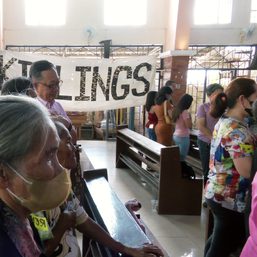SUMMARY
This is AI generated summarization, which may have errors. For context, always refer to the full article.
![[ANALYSIS] As food prices soar, Duterte allows return of ‘stagflation’](https://www.rappler.com/tachyon/2021/02/soaring-prices-stagflation-February-5-2021.jpg)
This is the perfect economic storm.
Last year the Philippine economy’s growth rate dropped to its lowest level since World War II. That means lower incomes for the average citizen, millions of Filipinos pushed out of the labor force and into poverty, business closures left and right.
As if that’s not bad enough, prices are now shooting up like crazy, too.
To buy a kilo of pork, for instance, could set you back P400 in some places. A kilo of chicken might cost P170. And a kilo of siling labuyo could exceed P1,000.
All this is corroborated by the latest government statistics released today, February 5.
In January 2021, the inflation rate — which measures how fast prices in general are rising — climbed to 4.2%. That’s the highest since February 2019 (nearly 2 years ago), and already in excess of the 4% upper inflation target set by government.
This rare combination of economic stagnation and elevated inflation is also called “stagflation.” Why is this happening now, and what can government do about it?
Figure 1.
High inflation again
This is not our first brush with sky-high prices under the Duterte administration.
Figure 1 reminds us of the painful spell of high inflation in 2018, when it peaked at 6.7% in September and October of that year. We suffered the worst inflation rate in ASEAN back then. (READ: Why is Philippine inflation now the highest in ASEAN?)
There were many reasons for that, chiefly the 2017 Train law (which hiked excise taxes on petroleum products, among other things), as well as high world oil prices, a relatively weak peso, and people’s expectations about inflation. To varying degrees, all these factors led to a tremendous rise in food prices especially for rice, vegetables, and meat.
Fast forward to January 2021, and history seems to be repeating itself.
Figure 2 shows that food items, again, contributed the most to the inflation uptick. At a distant second place, transportation prices also picked up. (Tricycle fares inflated by 46.7%!)
Figure 2.
Figure 3 shows that among food items, meat and vegetables are much to blame.
Figure 3.
As for vegetables, the Department of Agriculture projects for this year a supply shortfall of about 434,840 metric tons, equivalent to 79 days of shortage.
Recurring vegetable shortages are long-standing, caused primarily by, say, the chronic lack of post-harvest facilities (like those for cold-storage) as well as poor coordination of crop planting and harvesting.
These problems are nothing new, of course, but they underscore the need for more attention and funding from our agriculture policymakers.
‘Twindemic’
Much more disturbing is the astronomic rise of pork prices.
This is rooted in the government’s abysmal failure to contain yet another pandemic — the African swine fever or ASF — which first arrived in the country in late 2019, probably through pork smuggled from China. (Sound familiar?)
ASF has since spread in pig farms across the country. By one alarming estimate, ASF has already decimated 36% or more than a third of the country’s pig stocks.
Government is allegedly understating the pig death toll, but the steep rise of pork prices betrays the extent of the current shortages. In Metro Manila alone, prices of fresh pork (no bones) ballooned by a whopping 77% in January; prices of fresh pork with bones rose by 68%.
Chicken prices are rising, too, as people switch to pork substitutes.
President Rodrigo Duterte stepped in by imposing a 60-day ceiling on pork and chicken prices. But economists warn that absent measures to effectively contain ASF, this price ceiling will do little to abate the pork shortages — which could even worsen if artificially low prices dissuade sufficiently many producers from selling pork.
Apart from the price ceilings, there are also proposals to lower tariffs (taxes) on imported pork. But the projected additional supplies won’t be nearly enough to eliminate the shortages. And local pork producers rightly fear that the influx of imports could wipe out their businesses altogether.
It seems especially harsh that Filipinos today should suffer what is essentially a “twindemic”: COVID-19 and ASF. But until the Duterte government manages ASF, pork supplies won’t recover any time soon. Filipinos will continue to feel the pinch of skyrocketing prices, on top of their dwindled incomes.
Some analysts have hailed agriculture as the most robust sector in our economy amid the pandemic — in stark contrast to the collapse of both industry and services. But this assessment turns out to be premature; agriculture shrank by 1.2% last year.
Put cash in people’s hands
The steep rise of basic commodity prices couldn’t come at a worse time.
When you’ve lost your job and suffered a staggering loss of income, the last thing you need is a price acceleration that further diminishes the purchasing power of the little money you have left.
In a typical recession, prices ordinarily don’t rise too much. Anemic demand for goods and services can only put too much pressure on prices. But when prices rise due to supply rather than demand shocks, stagflation occurs and results in even more economic misery.
The last time we experienced stagflation was during our last recession in 1991. Previous to this, we experienced even worse stagflation in the dying years of martial law: as economic growth plummeted by 7% in 1984, inflation reached its historic high of 50%.
Today’s inflation is nowhere near 50%. But with last year’s 9.5% economic contraction beating the nadir during martial law, things are no less unsettling now.
To abate people’s suffering, the most obvious solution is to put money directly into the hands of people. Cash transfers akin to last year’s Bayanihan 1 emergency subsidies can help tide our people over.
But it bears repeating that the Duterte government has totally abandoned future rounds of such cash transfers, wrongly citing, say, the need for fiscal prudence. Even as our economy fights for its life in the ICU, Duterte and his ilk are essentially pulling the plug on all the life-saving equipment.
The current crisis only spotlights the government’s continuing lack of concern for the plight of our people — especially the poor. (READ: Filipinos are in misery, but why is Duterte slashing economic aid?)
Another crisis looms, by the way: if this stagflation goes on any further, expect heightened social unrest.
Good governance matters
Government officials gave their assurances that the recent inflation spike is but “transitory.” It remains to be seen how true this is.
Meanwhile, bear in mind that the current stagflation could’ve been avoided entirely. By no means was it inevitable.
Had the Duterte government acted earlier and more seriously against COVID-19, we would’ve averted a recession, as did Vietnam.
Had the Duterte government paid more attention to agriculture, we would’ve prevented vegetable shortages and price spikes.
Had the Duterte government contained ASF, our pigs wouldn’t have died en masse, and pork prices today wouldn’t have gone through the roof.
Good governance matters. If Filipinos want to avoid similar episodes of needless economic suffering in the future, they better vote a lot wiser in 2022. – Rappler.com
JC Punongbayan is a PhD candidate and teaching fellow at the UP School of Economics. His views are independent of the views of his affiliations. Follow JC on Twitter (@jcpunongbayan) and Usapang Econ (usapangecon.com).
Add a comment
How does this make you feel?



![[Just Saying] Diminished impact of SC Trillanes decision and Trillanes’ remedy](https://www.rappler.com/tachyon/2024/04/Diminished-impact-of-SC-Trillanes-decision-and-remedy.jpg?resize=257%2C257&crop=273px%2C0px%2C720px%2C720px)
![[Rappler Investigates] Son of a gun!](https://www.rappler.com/tachyon/2024/03/newsletter-duterte-quiboloy.jpg?resize=257%2C257&crop=450px%2C0px%2C1080px%2C1080px)
There are no comments yet. Add your comment to start the conversation.